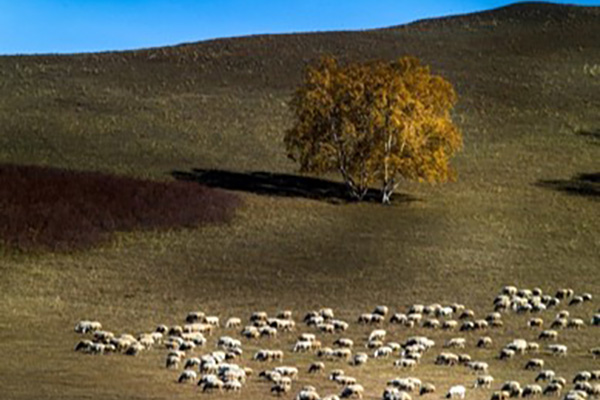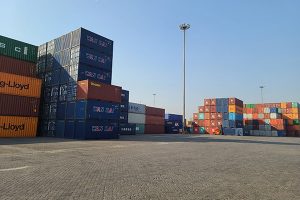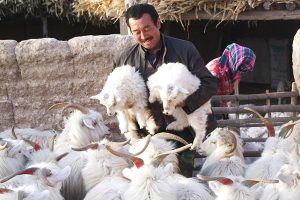The Inner Mongolia Fiber Quality Monitoring Center has carried out dynamic monitoring of the fiber quality of cashmere goats in the Rongshan area to provide data support for the entire industry chain.
“In the past, we blindly pursued the quantity and output of cashmere goats, resulting in the degradation of individual performance of the Albas cashmere goats, a decrease in average cashmere production and quality, a low lambing rate, and a loss of overall quality advantages,” said Bo Yongming, chairman of the Inner Mongolia Ordos Agricultural and Animal Husbandry Investment and Development Co., Ltd. “To do this traditional industry well and make it strong, we must first ensure the advantages of high-quality breeds.”
According to reports, in the Science and Technology Prosperity Project in Inner Mongolia-Ordos City Cashmere Goat Excellent Breeding and Industrial Innovation Development Demonstration Project, Etoke Banner has started with the source and improved the production performance of cashmere goats through selection and breeding, promoting the establishment of a high-quality population of Albas cashmere goats with ultra-fine, versatile, and high-fertility characteristics. This has driven the healthy, rapid, and sustainable development of the industry. Currently, Albas cashmere goats have become the image spokesperson for Etoke Banner.
“Technological innovation is helping the development of the cashmere industry, starting with good cashmere from a good goat.” This is the consensus reached by the project team. Who determines whether cashmere is good or not? “We are responsible for the research of wool quality evaluation, tracing, judging, and reasonable utilization in the project, and carry out dynamic monitoring of fiber quality of cashmere goats, using authoritative data to scientifically determine the quality of cashmere, and providing data support for technological intervention in various links of the entire industry chain,” said Wang Li, director of the Inner Mongolia Fiber Quality Monitoring Center.
The Inner Mongolia Erdos Agricultural and Animal Husbandry Investment Development Co., Ltd., Inner Mongolia Academy of Agriculture and Animal Husbandry Sciences, and Inner Mongolia Fiber Quality Monitoring Center, as project team units, worked together with the Agricultural and Animal Husbandry Bureau of Etoke Banner and the Agricultural and Animal Husbandry Technology Promotion Center of Ekeqian Banner to verify the project’s demonstration households. Over the past two years of project implementation, it has covered more than 3,000 herders in Etoke Banner, cultivated and promoted 2,587 high-quality breeding sheep, over 49,900 ewes, and 14,490 efficient breeding ewes. The breeding rate of ewes in the demonstration households reached 110.26%, the lambing rate reached 136.6%, and the number of ewes with a wool fineness of 14.5 micrometers or less in the core breeding area accounted for more than 45% of the basic ewes. The individual wool production of adult ewes reached over 600 grams, and the economic benefits increased by over 31 million yuan. A total of 47,927 Albas Cashmere goats from 479 herders in six towns were monitored for fiber quality, and monitoring results and analysis reports were promptly fed back. Herders, cooperatives, and breeding farms followed the monitoring results to select better quality and discard inferior products. At the same time, on-site sampling inspections were conducted on the Erdos Cashmere Auction to provide a basis for the pricing of cashmere trading and to promote the establishment of a high-quality and high-price trading mechanism. The monitoring results showed that the fineness of cashmere in Etoke Banner decreased by 0.55 micrometers in 2022.
“In the past, it was difficult to find wool with a fineness of 15.5 micrometers or less, but now over 80% of the wool in my home is 15.5 micrometers or less, and the finest one has reached below 12 micrometers,” said herder Siqingbilege happily. In 2021, when the Erdos Cashmere collection and storage subsidy funds were distributed, Siqingbilege received a high-quality and high-price subsidy of 28,575 yuan. Data showed that in 2022, based on the purchase price, the Etoke Banner government encouraged enterprises to increase rewards by 50 to 500 yuan per kilogram based on the fineness of cashmere, directly increasing the income of 270 farmers and herders by more than 2 million yuan.
It is worth mentioning that, relying on dynamic monitoring of fiber quality in research projects, a fiber quality database has been established for the first time, and a large-scale data tracing platform for cashmere fiber quality has been developed. This platform is linked to the Inner Mongolia Erdos cashmere industry big data platform, achieving data sharing, and providing guidance for the breeding of high-quality mountain goats, scientific breeding, and cashmere grading. A “Digital Hall” WeChat mini program for cashmere quality has been developed, allowing farmers and herdsmen to easily check their own mountain goat cashmere quality monitoring data at any time. This project provides technical support for the cultivation of advantageous brands and traceability of raw materials in the cashmere industry. In addition, carbon footprint calculation and evaluation studies of the entire life cycle of the cashmere industry have been carried out, providing a basis for promoting ecological and high-end development of Inner Mongolia’s cashmere industry.
“To build a world-class cashmere industry, the trump card is breeding sources.” Wang Youzhi, the head of Ejit Banner’s Yijihan Cashmere Product Co., Ltd., has always emphasized the importance of breeding sources for the development of the industry. “We must seek profits from science and development from technology,” said Sun Haizhou, the vice president of Inner Mongolia Agricultural and Animal Husbandry Science Academy. Technological innovation is the driving force for the transformation and upgrading of traditional industries. While reducing costs, increasing production capacity, protecting the ecology, and expanding income, it is also essential to maintain the fundamental livelihood of herdsmen. The “Technology Promotion of Inner Mongolia’s Cashmere Industry – Ejinaqi Mountain Goat Breeding and Industrial Innovation Development Demonstration Project” has turned the aspirations of Ejinaqi herdsmen into reality, and has enabled them to lead better lives.
Reference: Chinese Quality News



